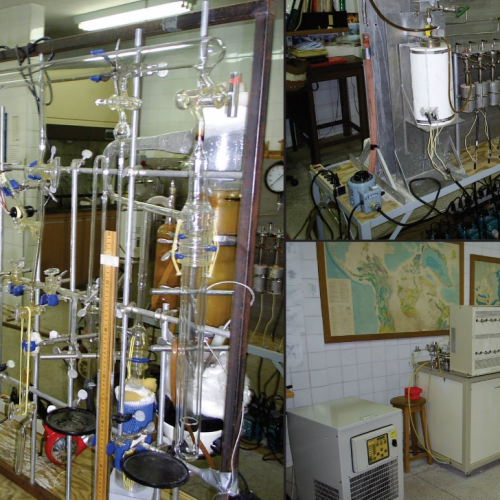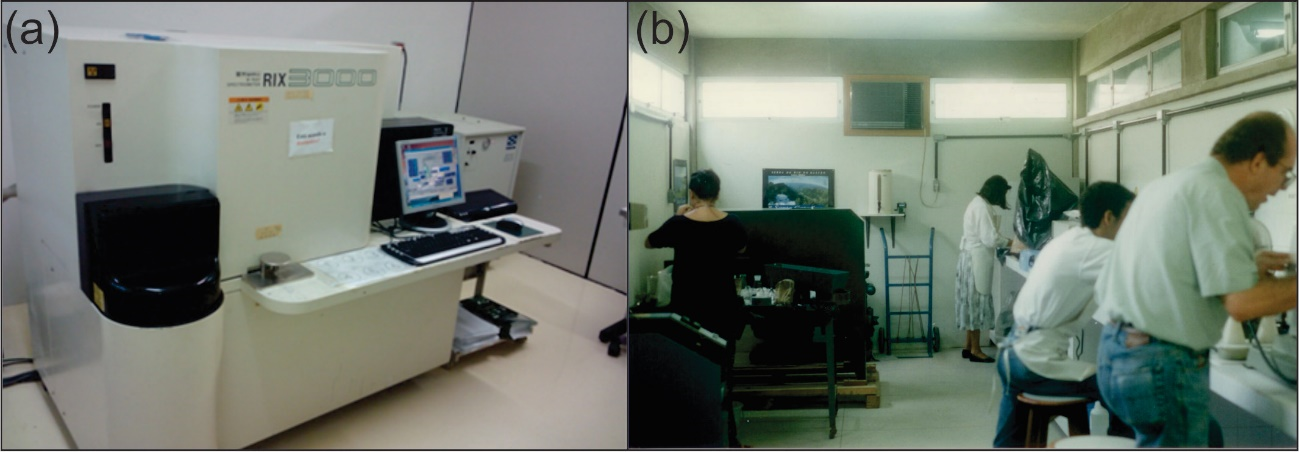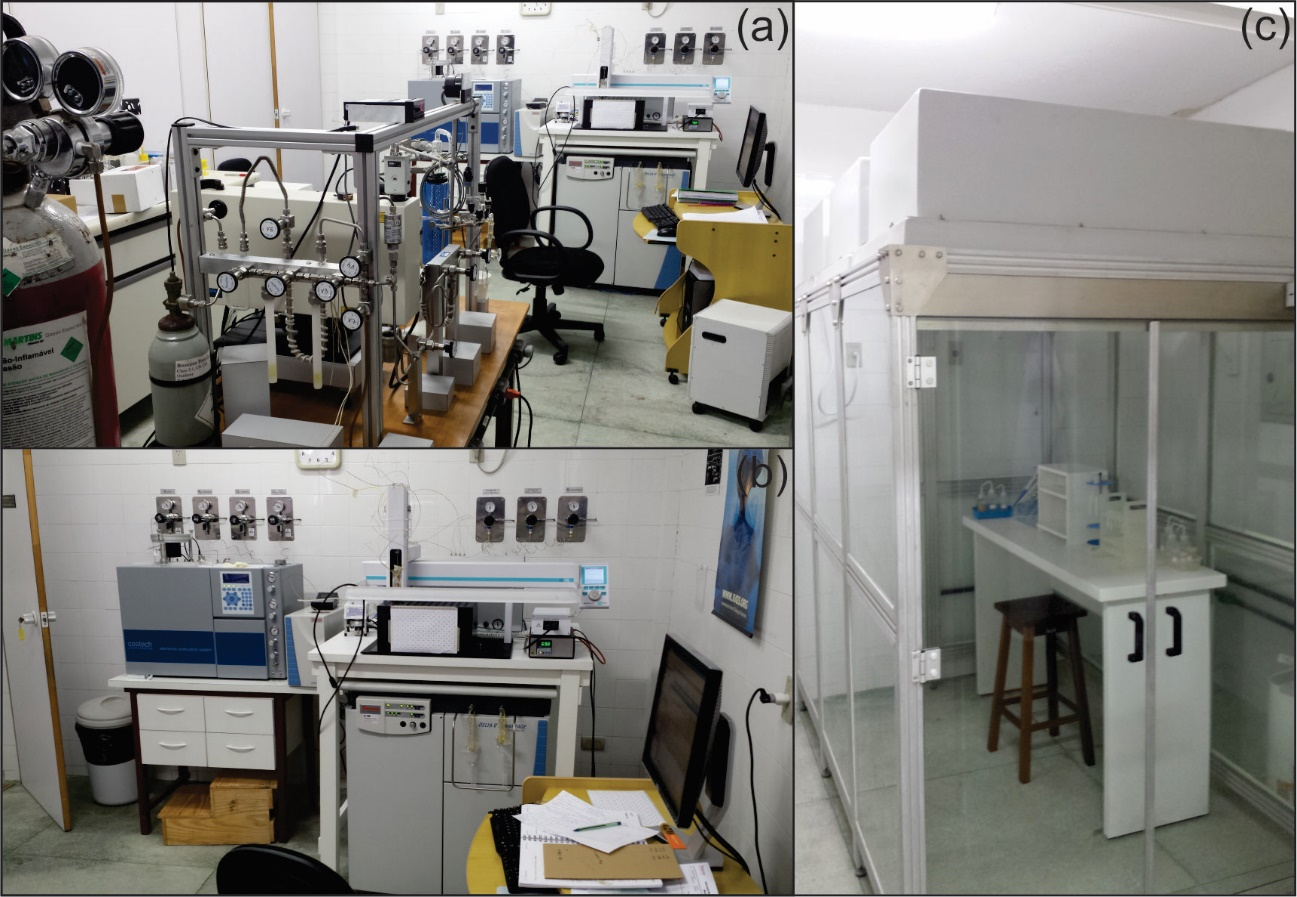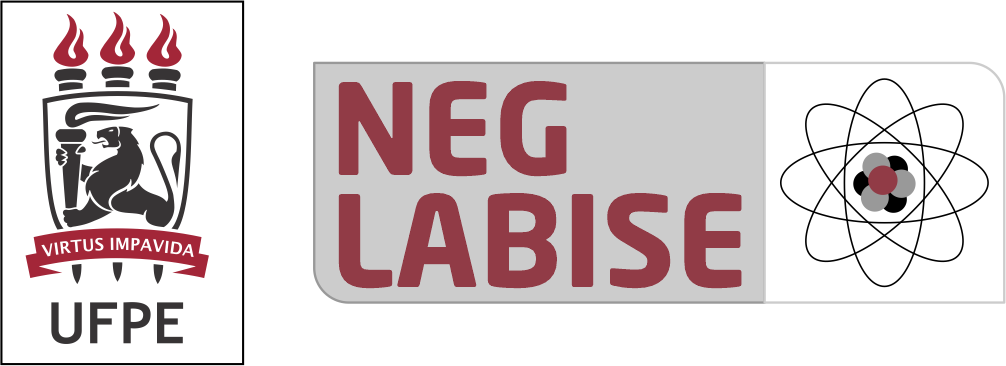
The History of NEG-LABISE
Alcides N. Sial was introduced to low- and high-temperature stable isotope geochemistry by Prof. Lynton Land during his postdoctoral work in the Department of Geological Sciences at the University of Texas (UT) at Austin (1977–1978). During this period, he learned about oxygen extraction from silicates using a conventional high-vacuum extraction line with bromine Br2F5 as the main reagent, as well as how to use hydrogen gas extraction and how to operate an old gas-source mass spectrometer (Nuclide).
The positive experience at UT encouraged A. N. Sial to expand his training in stable isotope geochemistry and visit other stable isotope laboratories in the US. For this purpose, he spent the entire year of 1983 at the University of Georgia, where he encountered the multiple applications of stable isotopes and related laboratory techniques. In the same year, he spent two months at the Department of Geology of the Memorial University of Newfoundland, Canada, learning the analytical method for the analysis of rare earth elements by X-ray fluorescence from Prof. Brian Fryer.
The challenging complexity of granites, their metallogeny and importance in the reconstruction of the geotectonic scenario, encouraged A.N. Sial to found the Granite Studies Center (NEG) of the Geology Department of UFPE in February 1984. Since then, the NEG has been developing studies on granitic rocks from northeastern Brazil, Argentina, Chile, Uruguay and India, mainly on igneous processes and investigation of the origin of granitic magmas (calcic-alkalic, peralkaline, alkalic-high-K, trondhjemitic and ultrapotassic). Special attention was given to cordierite-bearing granitoids in Argentina and Chile, and to epidote-bearing granitoids in Brazil, Argentina, Chile and Uruguay. Later, in 1995, the name of this Center was changed to Center for Geochemical Studies, preserving the acronym NEG.
In 1988, two conventional high-vacuum extraction lines (carbonate and silicate) were built with the help of David Wenner and Andrew Clarke while A.N. Sial was a postdoctoral fellow and V.P. Ferreira was a doctoral student at the University of Georgia. That same year, the researchers spent the entire month of August at the Geological Survey of Japan in Tsukuba, learning from Prof. Akira Sasaki the technique of extracting sulfur from igneous rocks using the Kiba mass spectrometer for sulfur isotopes.
The scientific experience gained in all these stable isotope laboratories in the USA and Japan motivated A. N. Sial to found, with financial support from PADCT (Support Program for Scientific and Technological Development, financed by the World Bank), a stable isotope laboratory (LABISE) at the Federal University of Pernambuco, becoming the pioneer in Brazil in the analysis of oxygen isotopes from silicates. Thus, in September 1990, LABISE was founded and has been in full operation since 1991. In addition, in the last 10 years, much attention has also been devoted to the isotopic stratigraphy of Precambrian and Phanerozoic carbonates of South America and India.
In this endeavor, the Department of Geology had the sympathy of the Dean, Prof. Edinaldo Bastos, who built the physical space to house this laboratory, consisting of two high-vacuum extraction lines (Figure 1a) and a room for the mass spectrometer (SIRA II) (Figure 3c), in addition to rooms for professors/researchers. The high-vacuum extraction lines (carbonate and silicate) were built in the University of Georgia workshop and transferred to Recife, where they were reassembled by A. N. Sial, Gorki Mariano and Valderez P. Ferreira.

Prof. Efrem Maranhão, who replaced Prof. Edinaldo Bastos and Prof. Mozart Neves Ramos, financially supported the expansion of the LABISE physical space to accommodate an X-ray fluorescence laboratory (Rigaku-3000) in 1994 and a sample preparation room in 1996 (Figure 2).


In 1996, A. N. Sial and V. P. Ferreira spent a few weeks in Kilbride, eastern Scotland, visiting with Prof. Anthony E. Fallick the analytical facilities of the Scottish Universities Research and Reactors Centre (SURRC), one of the most comprehensive stable isotope laboratories in Europe (Figure 3). They also visited Prof. John Valley of the Department of Geology and Geophysics at the University of Wisconsin in 2001, learning about CO2 laser extraction lines for O2 in silicates.
Upon their return, LABISE underwent its final physical expansion to accommodate an ion exchange laboratory (clean station), a CO2 laser-based oxygen extraction line for silicates and oxides (built by Zachary Sharp, University of New Mexico), and an elemental combustion equipment (COSTECH) for carbon and nitrogen analysis in an on-line system with a gas source mass spectrometer (Thermofinigan Delta V Advantage) and, more recently, a GasBench II to accompany the latter. From 1986 to 1994, NEG-LABISE was staffed by Gorki Mariano, also trained at the University of Georgia, who assisted in the early stages of installing the stable isotope laboratory and operating the high vacuum fluorine extraction line.

The study of Neoproterozoic granitoids bearing magmatic epidotes in northeastern Brazil, Paleozoic in Argentina and Tertiary in Chile, represents perhaps one of the outstanding contributions of NEG‒LABISE to the field of granite petrology in articles published in international journals (1999, 2003, 2008, 2011, 2015). In these works, it was proposed that the partial digestion of magmatic epidotes by their calc-alkaline or high-K calc-alkaline host magma can be used to estimate their ascent rate.
The scientific production is very significant, currently comprising two hundred scientific articles (most of them in international journals), around 20 book chapters, 3 books and 12 special issues, most of which are published in international journals (Lithos, Chemical Geology, Precambrian research, Gondwana Research, JSAES, Annals of the Brazilian Academy of Sciences and the Brazilian Journal of Geology) and have emerged from the NEG-LABISE team.
NEG-LABISE has maintained close scientific cooperation in studies of granites and isotopic stratigraphy with researchers from Brazil, Argentina, Chile, Uruguay, Colombia, Mexico, Portugal, India and the United States. The NEG-LABISE team’s infectious enthusiasm for science has attracted young geologists to pursue postgraduate studies (more than fifty students have been supervised/co-supervised in master’s or doctoral work or both or as interns), postdoctoral work or long-term or short-term visits by geoscientists (Anil Maheswari, Manoj K. Pandit, Lalchand Govindram Gwalani and Vinod C. Tewari from India; Ignacio Sabino Garcia and Lucia Peral Gomez from Argentina; Jean Pierre Tchouankoue from Cameroon; Marcelo Solari from Chile; Pedro Morais from Portugal, in addition to several Brazilian researchers).
A.N. Sial and V.P. Ferreira have been igneous petrologists (basalts, mantle petrology, granites) since they were hired by UFPE (A.N. Sial, March 1967, and V.P. Ferreira, August 1989). But their versatility, enthusiasm and curiosity led them to other areas, such as isotopic stratigraphy. From 1995 onwards, the scientific interest of NEG-LABISE was extended to isotopic chemostratigraphy and, from then on, a continuous and fruitful cooperation was established with colleagues from Argentina (Silvio Peralta, Gilberto Florencio Aceñolaza, R. Narcizo Alonso and Alejandro J. Toselli), Uruguay (Claudio Gaucher and Jorge Bossi) and Chile (Miguel Angel Parada). This group has documented for the first time in South America the isotopic record of the Steptoean positive carbon isotope excursion (SPICE) and recognized for the first time the Sunwaptan negative carbon isotope excursion (SNICE) in the Argentine Precordillera. In addition, they recognized for the first time in South America the record of the Ordovician positive carbon isotope excursion MDICE, GICE and HICE. Anil Maheswari, A. N. Sial, Claudio Gaucher, Andrey Bekker, Valderez P. Ferreira, Jorge Bossi and Wilson Romano contrasted the record of the Paleoproterozoic Lomagundi excursion in India, Brazil and Uruguay. They found that this excursion is recorded in both shallow water and deep-water carbonates, negating a significant impact on stromatolite productivity and hypersaline conditions on carbon isotope values of carbonates deposited in shallow-water, open-marine and isolated basins.
Annually, LABISE, through the Postgraduate Program in Geosciences, UFPE, offers two courses on Chemostratigraphy (45 hours), one dedicated to the Precambrian and the other to the Phanerozoic. Based on these two courses, LABISE was responsible for preparing Chapter 2 of a book recently published by Elsevier on Chemostratigraphy.
Over the past ten years, research at NEG‒LABISE has focused on the possible use of Hg as a tracer of volcanism during climate change events. A database of Hg (presumed to be of volcanic origin) from the Cryogenian–Ediacaran carbonate cap and from carbonates across the Cretaceous–Paleogene boundary from several locations (Europe, South America, and India) is currently being built. The intention is to assess the extent of volcanism versus bolide impact in the K‒T boundary mass extinction. A new project focusing on the Permian–Triassic boundary is under development.
Since the beginning of NEG-LABISE, the dissemination of scientific knowledge has been one of A.N. Sial’s main objectives. Thus, several events were promoted and courses taught by him and V.P. Ferreira, such as those mentioned below:
– Mini-courses to disseminate the petrology of granitic rocks and high and low T geochemistry with stable isotopes at universities in the country (UFRGS, UFRJ, UFPA, UFPE, UFMG, UFMT), Univ. of Chile (Santiago, 2003), Latin American Congress (Medellín, 2011) and at several national meetings;
– Workshop on Granitic Magmatism and Associated Mineralizations in Caruaru, Pernambuco (1985), bringing together about 15 young Brazilian granite enthusiasts to see granitoids of unusual diversity and evolution;
– International Symposium on Granites and Associated Mineralizations (ISGAM, 1987, 1997)
– Granitic Magma and Associated Mineralizations, MAGMA (31st, 32nd and 33rd editions of the International Geological Congress – IGC);
– Brazilian Academy of Sciences, Rio de Janeiro (1993);
– 4th South American Symposium on Isotope Geology, SSAGI, Salvador, Brazil (2003);
– Annual meeting of the Brazilian Academy of Sciences in Recife since 1992 with lectures by renowned researchers from the most diverse areas of Geosciences and Exact Sciences;
– Extension course entitled “Stable and Radiogenic Isotopes” with a duration of 75 hours/class offered annually at DGEO/UFPE for undergraduate and graduate students from different areas of interest. It is now in its 26th edition (Figure 5).

